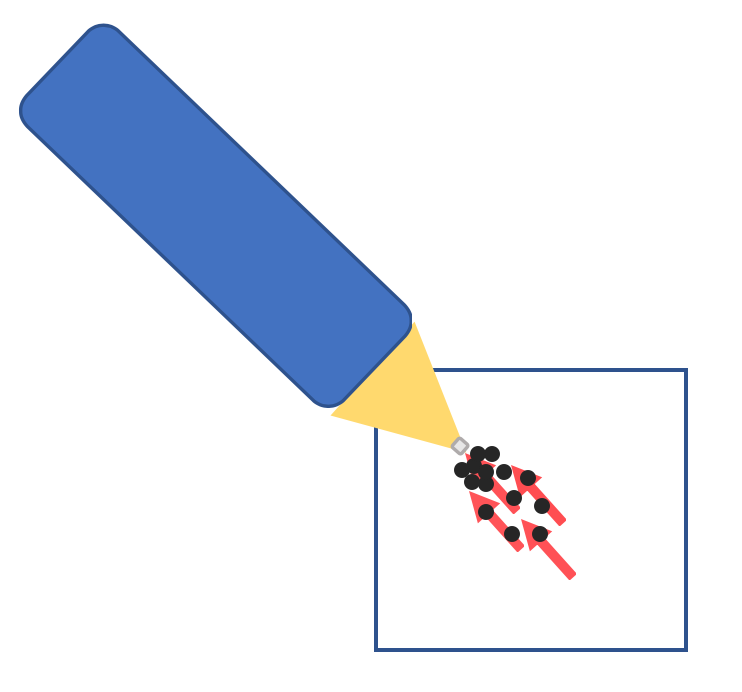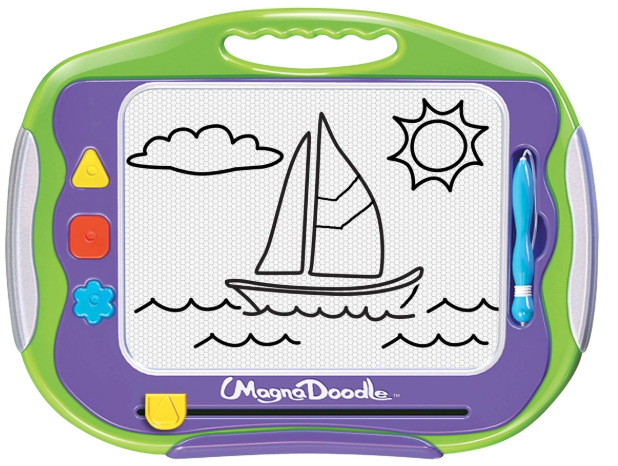The Original Magna Doodle: A Closer Look
Farha Zaman
The City College of New York
The toy that won most desired toy the year that it was released, the Magna Doodle was a huge success according to MeTV’s most desired toys of the 1970’s list. (MeTV’s staff, 2016). The Magna doodle was invented by Japanese engineers in 1947, and it was originally sold by Pilot pen company under Tyco. Tyco sold the toy to Mattel in 1997, who sold it under the Fisher-Price brand. From Mattel, Ohio art company owned the toy for a couple of years until finally it was sold to the current owners, Cra-Z-Art. While Magna doodles come in a variety of sizes, colors, and shapes, nothing beats the original (model code: r14626). Besides the owner selling it, nothing has changed about the magna doodle in the past 45 years.
Before the Magna Doodle, was the Etch A Sketch, which was a hit in the 1960s. (Englert, 2013). The Etch A Sketch was basically a plastic board, with a glass screen, aluminum powder, and joysticks. Children would use the two dials (or joysticks) to create their art, and then erase is by shaking the plastic console. While this was fun, it wasn’t as easy as it sounds, considering that there was no pen to draw with, you had to use the lines made by the etch a sketch when you turned the dials. There was also the Spirograph which was released in 1965, but this drawing toy was simply tools to make cool symmetrical patterns and required the traditional paper and pen. (Toy, Spirograph). Again, this was no competition for the Magna Doodle, which also allowed for kids to make shapes, but gave them a new innovative way to write and draw.
The Magna Doodle is quite simple, a few important parts make the whole magical experience possible. These part include the white magnetophoretic display, a magnetic pen with a string, an erasing magnet, the plastic case, and magnetic stamps. Firstly, the magnetophoretic is two pieces of transparent plastic, and inside the display is divided into a hexagonal plastic lattice that carries a thick white liquid and tiny magnetic particles. The walls of the middle lattice part are about 0.5mm thick and the liquid that fills the inside “…is water, glycol or organic solvent/oil-based, and has particulate thickeners: waxes- olefinic polymer, olefinic copolymer, was fatty acid derivatives-fatty acid amide, dextrin fatty acid ester metal soap.”( Freudenrich, 2001). This is what gives us the white background a user sees before using the pen to make dark marks on the screen. The magnetic particles are dark and about 10 microns fine, which allows them to be seen easily, and they are made of magnetic oxides. More specifically, these magnetic oxides include black magnetite, gamma-hematite, chromium oxide, ferrite magnetic alloys-iron, cobalt, and nickel. ( Freudenrich, 2001). Usually, dye is mixed in just to give a higher contrast between the white and the dark magnetic particles. The cells that they are divided into help to evenly distribute all the particles throughout the display, instead of ever accidentally attracting all the particles into one part of the display. The liquid and the particles have the same density, ensuring that the only way to change the placement of the particles is by a magnetic attraction.

Figure 1: You can see the hexagonal-honeycomb shape of the cells inside the Magna Doodle. Notice how all of the particles only go to the edge of their cells, indicating that the pen was gliding to the right, pulling the magnetic particles the edge of their cells where they cannot go anywhere else.

Figure 2: While you see the front of the board in figure one, in figure two you can see the back of the doodle board. All the magnetic particles sit in the back until the pen pulls them to the front, which is why there is a streak of particles that don’t appear in the back, because they have been pulled to the front.
The pen that comes with the Magna Doodle is a plastic pen with a magnetic tip. This magnetic tip attracts the particles from one side of the board to the other, and since that’s dark particles with a white background, you can draw and write with this pen. Attached to the pen is a white string that connects the pen to the board. This string is a life saver considering that without the pen, the doodle board is basically useless, not to mention that you don’t just find a magnetic pen in your local stationary store. The magnetic stampers have a similar function like the pen, but instead of for writing and drawing, these stamps are magnets that come in a specific shape. These shapes include triangle, square and a flower and based on the shape of the magnet, is the shape of particles that rise to the top of our display screen, revealing the shape we want. The pen is a blue color while the triangle is yellow, the square is red and the flower is the same blue as the pen.

Figure 3: As this illustration demonstrates, when a magnetic pen is brought to the board, all the magnetic particles are attracted towards the pen. Obviously, they cannot go past the display screen, but they do sit in the top of the board, bringing color to a white surface
Another important part is the eraser, which clears the screen for the next thing a user wants to create. The eraser consists of a bar magnet in the shape of a long thin rectangle, and as tall as the white magnetophoretic display is, that is attached to a plastic slider. It hides behind the second layer of plastic, in the back of the display, usually covered by the plastic case. There is a groove along the bottom of the case, in which the yellow eraser can slide through to erase everything. ( Freudenrich, 2001). Of course, the way that works is similar to the pen, the magnetic pull from the magnetic bar on the eraser pulls all the particles to the other side of their hexagonal cells, and out of sight from the front of the display screen, on to the back.

Figure 4: The picture is a magnetic eraser bar that has been removed from the plastic case of the Magna Doodle.
Last but not least, the case holds all of these parts together. The case has a purple front piece that provides the flat surface for the display. Here we have the front of the magnetophoretic display screen that a user can write on. There is a molded pen holder as well as a string that connects it to the pen. The case also has molded holders for each of the stampers that are included with the Magna Doodle Original. The case is even shaped to have a holder in the top so that users can hold it at the very top, and this part is green. The outermost sides of the Magna Doodle have a silver edge, for style. In the back piece of the case again is a flat surface that holds the magnetophoretic display, and a different flat area to easily slide the eraser along the back of the display. All of these components work together to form a Magna Doodle Board.

Figure 5: The Original Magna Doodle as sold by Cra-Z-Art.
The Magna Doodle is popular with parents for many different reasons. It doesn’t have ink or lead. It isn’t a chalk that kids can put in their mouths, and its mess free. There is no worrying about losing the pen or ever losing the eraser because both things are built in. Children love the shapes as it helps them learn to draw them, which helps them when they go to school and have to draw those same shapes. Furthermore, the Magna doodle original board is useful for scuba instructors who need something that won’t wash away or fade with water.
The Magna Doodle is a very popular toy even in todays day. The best thing about it may be its ability to be a toy and a learning tool for people of all ages. The Magna Doodle is definately worth the investment, as people of all ages can find it helpful in their everyday tasks or everyday fun.
References
Englert, S. (2013, December 15). Top toys of the 1960s. Retrieved April 25, 2019, from https://a
mericanprofile.com/articles/top-toys/
Freudenrich, C. (2001, February 07). How Magna Doodle Works. Retrieved March 20, 2019,
from https://entertainment.howstuffworks.com/magna-doodle6.htm
Pilla, N. (2013, September 16). Magna Doodle Presentation. Retrieved April 04, 2019, from
https://prezi.com/gynvhxvwnjed/magna-doodle-presentation/
Staff, M. (2016, December 8). The 13 most desired toys of the 1970s, year by year. Retrieved
March 20, 2019, from https://www.metv.com/lists/the-13-most-desired-toys-of-the-1970s-year-by-year
Townsend, A. (2011, February 16). All Time 100 Greatest Toys. Retrieved March 30, 2019,
from http://content.time.com/time/specials/packages/article/0,28804,2049243_2048657_
2049163,00.html
Toy, Spirograph. (n.d.). Retrieved April 27, 2019, fromhttps://americanhistory.si.edu/collections/
search/object/nmah_1292825
Welcome! (n.d.). Retrieved April 26, 2019, from https://www.shopmyexchange.com/cra-z-art-
original-magnadoodle-deluxe/7238906

